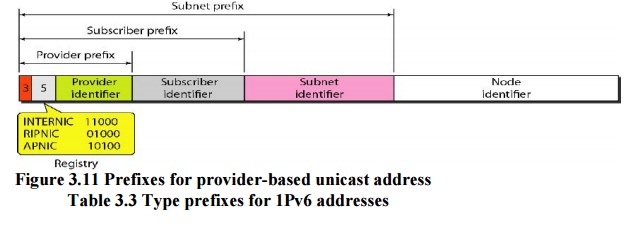Chapter: Computer Networks : Network Layer
IPv6 Addresses
IPv6 Addresses
Despite
all short-term solutions, such as classless addressing, Dynamic Host
Configuration Protocol (DHCP) and NAT, address depletion is still a long-term
problem for the Internet. This and other problems in the IP protocol itself,
such as lack of accommodation for real-time audio and video transmission, and encryption
and authentication of data for some applications, have been the motivation for
IPv6.
1. Structure
An IPv6
address consists of 16 bytes (octets); it is 128 bits long. An IPv6 address is
128 bits long.
2. Hexadecimal Colon Notation
To make
addresses more readable, IPv6 specifies hexadecimal colon notation. In this
notation, 128 bits is divided into eight sections, each 2 bytes in length. Two
bytes in hexadecimal notation requires four hexadecimal digits. Therefore, the
address consists of 32 hexadecimal digits, with every four digits separated by
a colon

3. Abbreviation
Although
the IP address, even in hexadecimal format, is very long, many of the digits
are zeros. In this case, we can abbreviate the address. The leading zeros of a
section (four digits between two colons) can be omitted. Only the leading zeros
can be dropped, not the trailing zeros.
Using
this form of abbreviation, 0074 can be written as 74, 000F as F, and 0000 as 0.
Example 3.11
Expand
the address 0:15:: 1:12:1213 to its original.
Solution
We first
need to align the left side of the double colon to the left of the original
pattern and the right side of the double colon to the right of the original
pattern to find now many Os we need to replace the double colon.
xxxx: xxxx:
xxxx: xxxx: xxxx: xxxx: xxxx: xxxx
0: 15: :
l: 12: 1213
This
means that the original address is
0000:
0015: 0000: 0000: 0000: 0001: 0012: 1213
4. Address Space
IPv6 has
a much larger address space; 2128 addresses are available. The designers of
IPv6 divided the address into several categories. A few leftmost bits, called
the type prefix, in each address
define its category. The type prefix is variable in length, but it is designed
such that no code is identical to the first part of any other code. In this
way, there is no ambiguity; when an address is given, the type prefix can
easily be determined.
5. Unicast Addresses
A unicast address defines a single
computer. The packet sent to a unicast address must be delivered to that
specific computer. IPv6 defines two types of unicast addresses: geographically
based and provider-based. We discuss the second type here; the first type is
left for future definition. The provider-based address is generally used by a
normal host as a unicast address.

Fields
for the provider-based address are as follows:
·
Type
identifier: This 3-bit field defines the address as a
provider-based address.
·
Registry
identifier. This 5-bit field indicates the agency that has
registered the address.Currently three registry centers have been defined.
INTERNIC (code 11000) is the center for North America; RIPNIC (code 01000) is
the center for European registration; and APNIC (code 10100) is for Asian and
Pacific countries.

·
Provider
identifier. This variable-length field identifies the provider
for Internet access(such as an ISP). A 16-bit length is recommended for this
field.
·
Subscriber
identifier. When an organization subscribes to the Internet
through a provider, itis assigned subscriber identification. A 24-bit length is
recommended for this field.
·
Subnet
identifier. Each subscriber can have many different
subnetworks, and eachsubnetwork can have an identifier. The subnet identifier
defines a specific subnetwork under the territory of the subscriber. A 32-bit
length is recommended for this field.
·
Node
identifier. The last field defines the identity of the node
connected to a subnet. Alength of 48 bits is recommended for this field to make
it compatible with the 48-bit link (physical) address used by Ethernet. In the
future, this link address will probably be the same as the node physical
address.
6. Multicast Addresses
Multicast
addresses are used to define a group of hosts instead of just one. A packet
sent to a multicast address must be delivered to each member of the group.

The
second field is a flag that defines the group address as either permanent or
transient. A permanent group address is defined by the Internet authorities and
can be accessed at all times. A transient group address, on the other hand, is
used only temporarily. Systems engaged in a teleconference, for example, can
use a transient group address. The third field defines the scope of the group
address. Many different scopes have been defined.
7. All cast Addresses
IPv6 also
defines anycast addresses. An anycast address, like a multicast address, also
defines a group of nodes. However, a packet destined for an anycast address is
delivered to only one of the members of the anycast group, the nearest one (the
one with the shortest route). Although the definition of an anycast address is
still debatable, one possible use is to assign an anycast address to all
routers of an ISP that covers a large logical area in the Internet.
8. Reserved Addresses
Another
category in the address space is the reserved address. These addresses start
with eight Os (type prefix is 00000000). A few subcategories are defined in
this categor.

An
unspecified address is used when a host does not know its own address and sends
an inquiry to find its address. A loopback address is used by a host to test
itself without going into the network. A compatible address is used during the
transition from IPv4 to IPv6.
9. Local Addresses
These
addresses are used when an organization wants to use IPv6 protocol without being
connected to the global Internet. In other words, they provide addressing for
private networks. Nobody outside the organization can send a message to the
nodes using these addresses. Two types of addresses are defined for this
purpose.

Related Topics